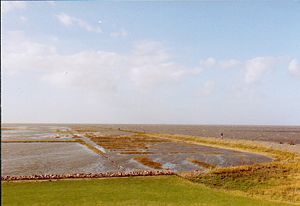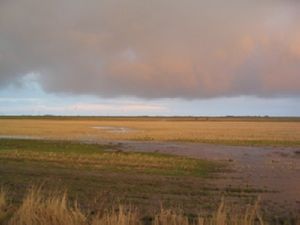Dithmarschen: Difference between revisions
imported>Alexander Wiebel (Don't need these cat anymore we have a checklist now) |
imported>Meg Taylor m (spelling: troups -> troops) |
||
| (2 intermediate revisions by 2 users not shown) | |||
| Line 2: | Line 2: | ||
[[Image:Friedrichskoog.jpg|thumb|300px]] | [[Image:Friedrichskoog.jpg|thumb|300px]] | ||
[[Image:Westerkoog.jpg|thumb|300px]] | [[Image:Westerkoog.jpg|thumb|300px]] | ||
Dithmarschen is a district in the state of [[Schleswig-Holstein]] in [[Germany]]. It is situated between the [[North Sea]] and the rivers [[Eider]] and [[Elbe]] and the North-East-Canal. From the early Middle Ages until 1559, Dithmarschen was a free peasants’ republic. | '''Dithmarschen''' is a district in the state of [[Schleswig-Holstein]] in [[Germany]]. It is situated between the [[North Sea]] and the rivers [[Eider river|Eider]] and [[Elbe river|Elbe]] and the North-East-Canal. From the early Middle Ages until 1559, Dithmarschen was a free peasants’ republic. | ||
Dithmarschen consists of marshes and coastal heathland. Important towns are Heide, Meldorf, [[Brunsbüttel]], Marne, Wesselburen and the touristic place [[Büsum]]. | Dithmarschen consists of marshes and coastal heathland. Important towns are Heide, Meldorf, [[Brunsbüttel]], Marne, Wesselburen and the touristic place [[Büsum]]. | ||
With the administration reform of 1970, Northern and Southern Dithmarschen have come together to form one unit, the district of Dithmarschen with its capital Heide. | With the administration reform of 1970, Northern and Southern Dithmarschen have come together to form one unit, the district of Dithmarschen with its capital Heide. | ||
The oldest archeological finds in Dithmarschen are from the early paleolithic age. There was settlement in the marshes. | The oldest archeological finds in Dithmarschen are from the early paleolithic age. There was settlement in the marshes. | ||
In 804, Charlemagne conquered Dithmarschen and the neighbouring districts. For the next thousand years, Dithmarschen belonged to the county of [[Saxonia]]. | In 804, Charlemagne conquered Dithmarschen and the neighbouring districts. For the next thousand years, Dithmarschen belonged to the county of [[Saxonia]]. | ||
After the battle of Bornhöved in 1227, the district belonged to the archdiocese of [[Bremen]]. In 1500, the people of Dithmarschen defeated the Danish army under King John in the battle of Hemmingstedt. In 1559, the united | After the battle of Bornhöved in 1227, the district belonged to the archdiocese of [[Bremen]]. In 1500, the people of Dithmarschen defeated the Danish army under King John in the battle of Hemmingstedt. In 1559, the united troops of [[Demark]] and Schleswig-Holstein beat the Dithmarschen forces. | ||
The district was divided into three parts. When duke John of Schleswig-Holstein-Hadersleben died in 1581, his share was divided, so that soon the district had only two parts: Northern and Southern Dithmarschen. | The district was divided into three parts. When duke John of Schleswig-Holstein-Hadersleben died in 1581, his share was divided, so that soon the district had only two parts: Northern and Southern Dithmarschen. | ||
Latest revision as of 20:12, 14 February 2010
Dithmarschen is a district in the state of Schleswig-Holstein in Germany. It is situated between the North Sea and the rivers Eider and Elbe and the North-East-Canal. From the early Middle Ages until 1559, Dithmarschen was a free peasants’ republic. Dithmarschen consists of marshes and coastal heathland. Important towns are Heide, Meldorf, Brunsbüttel, Marne, Wesselburen and the touristic place Büsum. With the administration reform of 1970, Northern and Southern Dithmarschen have come together to form one unit, the district of Dithmarschen with its capital Heide. The oldest archeological finds in Dithmarschen are from the early paleolithic age. There was settlement in the marshes. In 804, Charlemagne conquered Dithmarschen and the neighbouring districts. For the next thousand years, Dithmarschen belonged to the county of Saxonia. After the battle of Bornhöved in 1227, the district belonged to the archdiocese of Bremen. In 1500, the people of Dithmarschen defeated the Danish army under King John in the battle of Hemmingstedt. In 1559, the united troops of Demark and Schleswig-Holstein beat the Dithmarschen forces.
The district was divided into three parts. When duke John of Schleswig-Holstein-Hadersleben died in 1581, his share was divided, so that soon the district had only two parts: Northern and Southern Dithmarschen.

